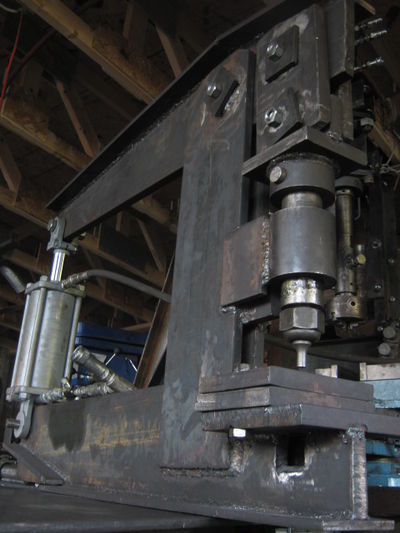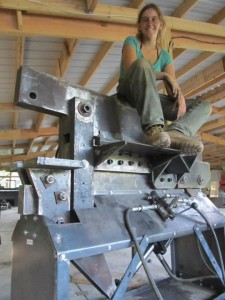Ironworker: Difference between revisions
Lucas Warner (talk | contribs) No edit summary |
(Adding version-specific pages) |
||
| Line 1: | Line 1: | ||
[[Image:Ironworker.png|thumb|right|400px|Ironworker]] | |||
=Overview= | |||
[[Image:Ironworker.jpg|thumb|400px|Ironworker Punch Press - Prototype I]] | |||
An Ironworker is the amalgamation of 5 machines clubbed into a single engineering wonder, forming the backbone of many fabrication workshops. An Ironworker comprises of a punching machine, a plate shear, a section shear, a punch and shear machine and a coper-notcher. | |||
Generating force using hydraulic systems or mechanical leverage, Ironworker machines can shear, punch holes and notch in steel plates. | |||
{{Video}} | |||
=Versions= | |||
==Ironworker 3== | |||
Main page for the [[Ironworker 3]]. | |||
Under active development as of Oct 2013 | |||
==Ironworker 2== | |||
TODO | |||
==Ironworker 1== | |||
TODO | |||
[[Image:Backhoe.jpg|100px|none]] | |||
=Details= | |||
They are typically mounted on the back of a tractor or front loader, this one is mounted on a [[LifeTrac]]. It consists of a digging bucket on the end of a two-part articulated arm. The section of the arm closest to the vehicle is known as the boom, and the section which carries the bucket is known as the dipper or dipperstick (the terms "boom" and "dipper" having been used previously on steam shovels). The boom is attached to the vehicle through a pivot known as the kingpost, which allows the arm to slew left and right, usually through a total of around 200 degrees. Modern backhoes are powered by hydraulics. | |||
The backhoe is one of the most basic dirt working tools and is a common attachment to many small tractor and skid-steer vehicles. It can be used for digging trenches for foundations, digging up material to make compressed earth blocks, digging waste pits, and many other common building/farming tasks. Furthermore, by attaching a chain to the bucket, the backhoe can be used to lift and transport heavy loads such as engine blocks, battery packs, long pieces of pipe, etc. | |||
Commercially manufactured backhoes vary greatly in their size and capabilities and therefore vary significantly in price. A quick google search seems to indicate that relatively small, simple devices like the one we are considering range from 2 to 4 thousand dollars with more sophisticated attachments approaching 10 thousand dollars. | |||
=Product Ecology= | |||
'''Made with''' | |||
*{{Induction Furnace}} | |||
*{{Torch}} | |||
*{{Torch Table}} | |||
*{{Welder}} | |||
'''Creates''' | |||
*[[Earth Moving]] | |||
=Videos= | |||
{{Video}} | |||
=See Also= | |||
*[[wikipedia:Backhoe |Wikipedia: Backhoe]] | |||
[[Category:Backhoe]] | |||
[[Category:Earth moving]] | |||
{{GVCS Footer}} | |||
{{GVCS Header}} | {{GVCS Header}} | ||
| Line 17: | Line 87: | ||
==Overview== | ==Overview== | ||
MOVED | |||
==Details== | ==Details== | ||
Revision as of 20:47, 24 October 2013
Overview
An Ironworker is the amalgamation of 5 machines clubbed into a single engineering wonder, forming the backbone of many fabrication workshops. An Ironworker comprises of a punching machine, a plate shear, a section shear, a punch and shear machine and a coper-notcher.
Generating force using hydraulic systems or mechanical leverage, Ironworker machines can shear, punch holes and notch in steel plates.
Versions
Ironworker 3
Main page for the Ironworker 3.
Under active development as of Oct 2013
Ironworker 2
TODO
Ironworker 1
TODO
Details
They are typically mounted on the back of a tractor or front loader, this one is mounted on a LifeTrac. It consists of a digging bucket on the end of a two-part articulated arm. The section of the arm closest to the vehicle is known as the boom, and the section which carries the bucket is known as the dipper or dipperstick (the terms "boom" and "dipper" having been used previously on steam shovels). The boom is attached to the vehicle through a pivot known as the kingpost, which allows the arm to slew left and right, usually through a total of around 200 degrees. Modern backhoes are powered by hydraulics.
The backhoe is one of the most basic dirt working tools and is a common attachment to many small tractor and skid-steer vehicles. It can be used for digging trenches for foundations, digging up material to make compressed earth blocks, digging waste pits, and many other common building/farming tasks. Furthermore, by attaching a chain to the bucket, the backhoe can be used to lift and transport heavy loads such as engine blocks, battery packs, long pieces of pipe, etc.
Commercially manufactured backhoes vary greatly in their size and capabilities and therefore vary significantly in price. A quick google search seems to indicate that relatively small, simple devices like the one we are considering range from 2 to 4 thousand dollars with more sophisticated attachments approaching 10 thousand dollars.
Product Ecology
Made with
Creates
Videos
See Also
| Ironworker | ||
|---|---|---|
| Home | Research & Development | Bill of Materials | Manufacturing Instructions | User's Manual | User Reviews | 
| |
Latest IronWorker file (June 6, 2013)
File:IronworkerBOM.skp
(This file also contains the Bill of Materials as the design currently stands.)
Ironworker Prototype II
See corresponding blog post - [1]
Spreadsheet of Links
https://docs.google.com/spreadsheet/ccc?key=0AlpsBarfpPkzdHkxTUF5QUs1aEswTzY5QlRnRG52Mmc#gid=0
Overview
MOVED
Details
Sketchup of prototype 1:
Product Ecology
Uses
 Induction Furnace Steel
Induction Furnace Steel Welder parts
Welder parts
Creates
See Product Ecologies for more information.
Components
- Structural Steel
- Pins
- Hydraulic Ram
- Controls
- Ironworking
- Press
- Punch - Die
- Shear
- Notcher
Status
The Ironworker is currently in the prototyping phase of product development, with hole-puncher and press variants in active use for CEB Press and PowerCube fabrication. Future prototypes aim to integrate shearing capabilities and solenoid controls.
See Also







